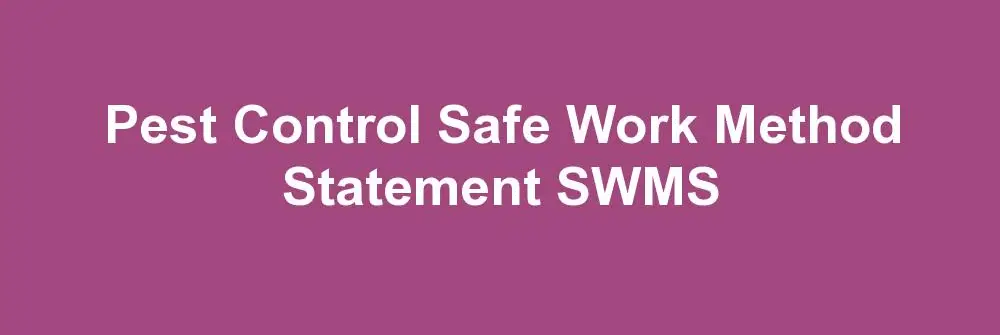It is essential to have a Pest Control Safe Work Method Statement (SWMS) to guide workers on the job steps to be followed and the potential hazards and control measures to be implemented. In this article, we will provide a comprehensive guide to the job steps covered in pest control SWMS.
Pest control is a critical aspect of modern living as it helps to keep our homes and workplaces free from pests that can cause structural damage, spread disease, and contaminate food. However, pest control can be a hazardous job if proper safety measures are not followed.
Table of Contents
Pest Control Safe Work Method Statement SWMS
Planning
Before starting any pest control job, it is essential to have a comprehensive plan in place. The plan should include the type of pest to be controlled, the location, the method to be used, and the potential hazards that may arise. The plan should also include the appropriate personal protective equipment (PPE) that workers should use.
Transporting Chemicals
Transporting chemicals to the pest control site is another critical step that requires careful planning. Workers should ensure that the chemicals are correctly labeled and packaged to avoid spillage during transportation. They should also ensure that the chemicals are transported in a secure vehicle and that the vehicle is not overloaded.
Arrival On-site & Assess On-site Conditions
When workers arrive on-site, they should assess the site conditions to identify potential hazards that may arise during the pest control process. They should also identify the location of electrical wiring, water pipes, and gas lines to avoid damaging them during the pest control process.
Working Outdoors
Pest control work often involves working outdoors, and workers should be aware of the potential hazards that may arise. They should wear appropriate PPE, including long-sleeved shirts, pants, and gloves, to protect themselves from insect bites and chemical exposure.
Work Area Preparation
Preparing the work area is another essential step in pest control. Workers should clear the work area of any obstacles and ensure that the area is well-ventilated. They should also ensure that the area is secure to avoid unauthorized access.
Environment
The environment in which pest control is carried out is also essential. Workers should be aware of the weather conditions and adjust their work accordingly. For example, they should avoid working during windy or rainy conditions as this can increase the risk of chemical exposure.
Housekeeping
Maintaining good housekeeping practices during the pest control process is crucial. Workers should ensure that all tools and equipment are clean and properly stored after use. They should also ensure that all chemicals are stored in a secure location away from the reach of children and pets.
Manual Tasks
Pest control work often involves manual tasks such as digging and lifting heavy objects. Workers should be trained on proper lifting techniques to avoid injuries. They should also be aware of the signs of strain injuries and take appropriate breaks when necessary.
Pesticide Application
The application of pesticides is the main activity in pest control. Workers should be trained on the proper application techniques, including the correct dosage and the appropriate spraying distance. They should also be aware of the potential hazards of exposure to pesticides and take appropriate measures to protect themselves and others.

Termite Barrier Fixing
Termite barrier fixing involves the installation of physical barriers to prevent termites from entering buildings. Workers should be trained on the proper installation techniques and the potential hazards that may arise during the process.
On Completion
After completing the pest control job, workers should ensure that all equipment is cleaned and properly stored. They should also ensure that all chemicals are properly disposed of according to the relevant regulations.
Emergency Response
Despite all the precautions taken, emergencies can still occur during the pest control process. Workers should be trained on the appropriate emergency response procedures, including first aid and
emergency response procedures, including first aid and what to do in the event of accidental exposure to chemicals. Workers should also be aware of the location of emergency exits and evacuation procedures in case of a fire or other emergency.
In conclusion, pest control is an essential service that helps to keep our homes and workplaces free from pests. However, it can also be a hazardous job if proper safety measures are not followed. The job steps covered in pest control SWMS, include planning, transporting chemicals, arrival on-site, working outdoors, work area preparation, environment, housekeeping, manual tasks, pesticide application, termite barrier fixing, on completion, and emergency response, providing a comprehensive guide to ensuring the safety of workers and others during the pest control process.
FAQs
What is a pest control Safe Work Method Statement (SWMS)?
A pest control SWMS is a comprehensive plan that outlines the job steps to be followed, the potential hazards, and the control measures to be implemented during the pest control process.
What personal protective equipment (PPE) should pest control workers use?
Pest control workers should wear appropriate PPE, including long-sleeved shirts, pants, and gloves, to protect themselves from insect bites and chemical exposure.
What should workers do in the event of accidental exposure to chemicals during the pest control process?
Workers should follow the emergency response procedures outlined in the pest control SWMS, including first aid and seeking medical attention if necessary.
What is termite barrier fixing?
Termite barrier fixing involves the installation of physical barriers to prevent termites from entering buildings.
Why is maintaining good housekeeping practices important during the pest control process?
Maintaining good housekeeping practices helps to ensure that all tools and equipment are clean and properly stored after use and that all chemicals are stored in a secure location away from the reach of children and pets. This helps to prevent accidents and reduce the risk of chemical exposure.
tag: Pest Control Safe Work Method Statement SWMS
